The Snowdrop, in purest white array, / First rears her head on Candlemas Day
February 2: Candlemas
The Snowdrop, in purest white array,
First rears her head on Candlemas DayTraditional
We’ve been noticing subtle changes here in our corner of the Pacific Northwest. It had just begun to seem as if winter’s early nightfall would never relent, and then we had our (annual) startling realization: there was still some light in the sky when we went to make dinner. After all these years, I don’t know how these seasonal changes catch me by surprise…somehow both gradual and sudden, fixed and transient.
“He has contrived to gratify both tastes together on the very world He has made, by that union of change and permanence which we call Rhythm. He gives them the seasons, each season different yet every year the same, so that spring is always felt as a novelty yet always as the recurrence of an immemorial theme. He gives them in His Church a spiritual ear; they change from a fast to a feast, but it is the same feast as before.”
C.S. Lewis, The Screwtape Letters
The mild weather & lengthening daylight reveal more animals to us - birds are returning, and we even heard frogs chorusing during a warm night. Bulbs are starting to send their bright yellow-green shoots up through the soil, heaps of pruned branches pile up, and the hedgerows glimmer with catkins. Even though we experience this cycle (with variation) every year, I still find myself surprised & delighted by each & every sign of spring appearing…signs that are paradoxically subtle yet momentous.
Deep, verdant springtime is still in the distance - but now we see the bridge from Winter to Spring being revealed right in front of us. It’s an anticipated, longed-for turning point in the seasons, yet it still feels like a fresh, delightful surprise.
As we pivot to Spring, the feast of Candlemas on February 2 bears the story of the infant Christ’s presentation in the Temple and the affirmations of Simeon & Anna in response. Their years of faithful anticipation give way to joyful recognition - a childlike, springtime delight. How fitting that we would celebrate this moment in Christ’s life as we enter into a new season!1
Art + Resources
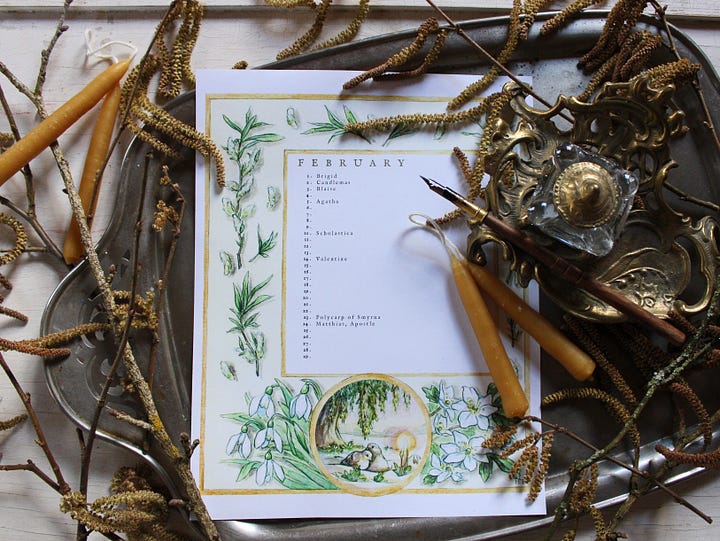
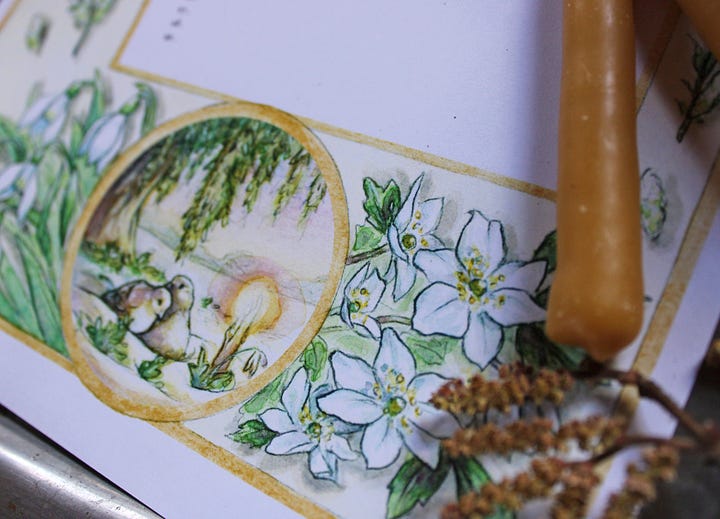

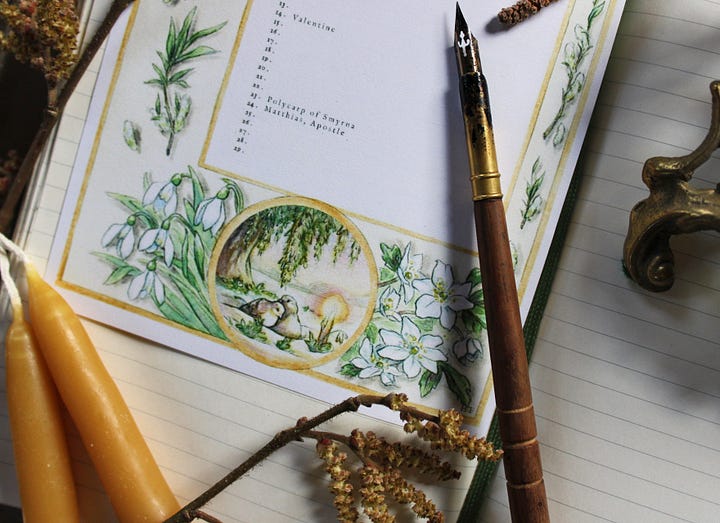
If you’ve been following along for a few months, I’ve been creating calendar pages inspired by a Medieval Book of Hours - the Huth Hours (painted by Simon Marmion ca. 1480). The calendar pages of the Huth Hours feature miniature scenes representing the “labors of the month”: farming tasks that defined the major work of that particular month. I’ve adapted that idea to focus-in on one particular feast for the month, letting it guide the design of the calendar page.
For February’s calendar, I’m featuring Candlemas symbolism:
Two turtledoves, recalling the sacrifice brought by the Holy Family to the Temple for the presentation of Jesus
Candlemas Bells (aka Snowdrops)
Candlemas Caps (aka Wood Anemone)
Osier Willow (thought to be the willow branches used to weave the basket that carried the doves to the Temple)

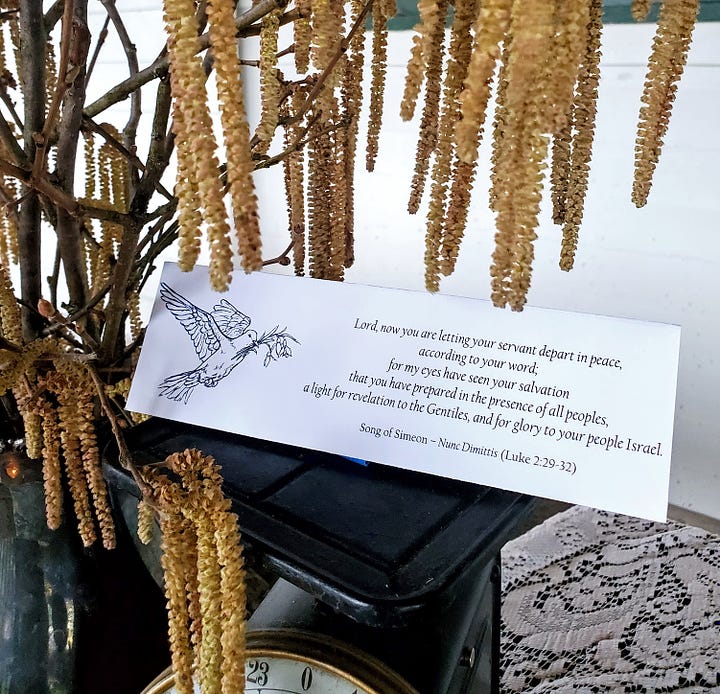
I also have a few other Candlemas printables for you - including place-tags for labeling food, etc., the Nunc Dimittis prayer, and some whimsical ornaments.
Paid subscribers, please hop over to the Scriptorium to download & print your goodies!
A Light for Revelation
“The feast of the Purification also marked…the early turning of winter into spring, and it was celebrated, appropriately enough, with dramatic darkness and dramatic light. Lit with an extraordinary display of candles, the church of St. Andrew welcomed the Penifaders out of the cold dawn of a February morning. After the mass, everyone paraded around the church with candles, and when this procession ended, other candles and tapers were blessed and then saved for use.”
Judith M. Bennett, A Medieval Life: Cecilia Penifader of Brigstock, c. 1295-1344
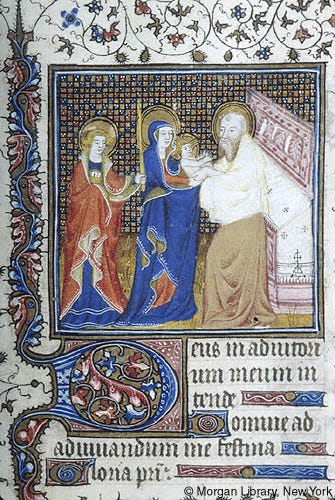
Closing out the infancy story of Jesus’ life, Candlemas is placed forty days after Christmas – right at the midway point between the Winter Solstice and Spring Equinox, just as we notice the lengthening of daylight and the appearance of early spring flowers.
This ancient feast traces its roots of celebration back to 350 AD, when it was held on February 14 (forty days after the feast of Epiphany, which was previously when the nativity was marked). By the 6th century, it had been moved to its present date of February 2, and it would become one of the most beloved & popularly celebrated feasts of the Middle Ages.
Candlemas goes by a few different titles: the Feast of the Presentation of Jesus Christ, commemorating the infant Christ’s presentation at the Temple (Mosaic Law held that firstborn sons, at about a month old, be presented to the Lord by the high priest), when Simeon & Anna recognized Him as the Messiah2; and the Feast of the Purification of the Blessed Virgin Mary (the mother of a newborn was to go through a span of 40 days of purification before presenting an offering at the Temple).3
Over the years, focus has shifted toward the theme of the Presentation - but, either way, Candlemas celebrates the culmination of faithful waiting in the context of community.
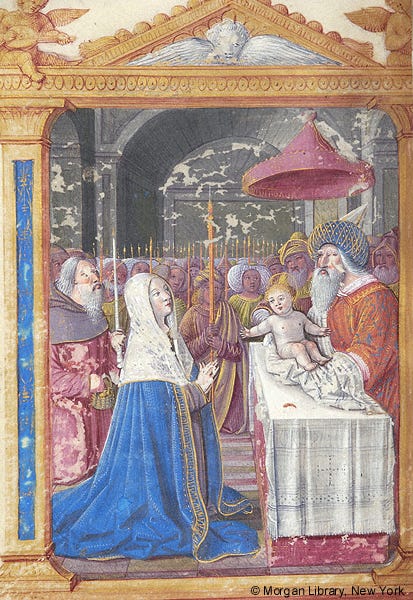
Alongside Simeon & Anna, we gather to affirm Christ’s illuminating presence:
Lord, now you are letting your servant depart in peace,
according to your word;
for my eyes have seen your salvation
that you have prepared in the presence of all peoples,
a light for revelation to the Gentiles, and for glory to your people Israel.Song of Simeon – Nunc Dimittis (Luke 2:29-32)
The Medieval church, so inspired by Simeon’s canticle (as well as the portrayal of Christ as Light in John’s gospel4), marked the celebration of this event in Christ’s life with candles5 - thus lending the feast its popular title of ‘Candlemas’. The dark church, illuminated with candlelight, would be filled with parishioners bringing their own candles to be blessed for the coming year (we even have descriptions of parishioners holding lit candles during the Candlemas liturgy dating as far as 450 AD!).
There was a belief that the candles blessed at this feast were especially imbued with a protective quality - particularly for the weathering of thunderstorms. In our modern world, we tend to lose sight of the immediacy of these fears; but, in these agrarian societies of yesteryear, the changing weather patterns during transitional times like Spring would have been crucial to the wellbeing of the whole community.
Watching dark storm clouds blowing in toward newly-plowed fields, and hearing thunder rumble in the distance, I can only imagine that a glowing taper would have felt all the more warm & comforting when its Candlemas blessing was called to mind. Like a glowing affirmation of hope amidst the temperamental Springtime weather.
Life lurks within the hedgerows
Hearthside, Table, & Field
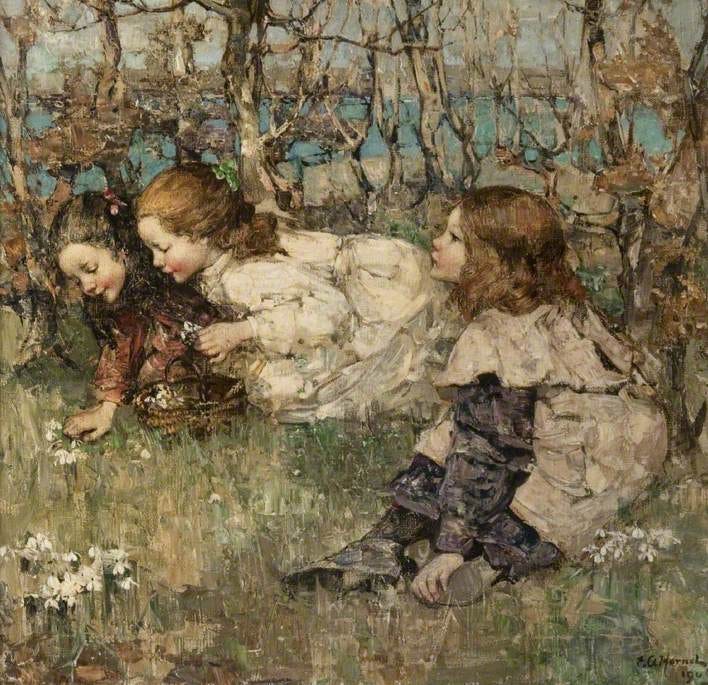
“Our ancestors, with their lively faith and rural lives, loved this festival [of Candlemas], and carried with them its recollection into their fields, and there they found that earth too was keeping it with them, and that in the aisles and naves of Nature’s cathedral, in the meadows and woods, she too repeated the pageant they had witnessed in their churches that morning. As the pure flower of the Snowdrop (Galanthus nivalis) rose among the thick grass and dotted their fields over with its white drooping bell, it was a remarkably striking reproduction of the picture they had beheld, and thus it became pre-eminently the flower of the feast.”
Alfred E. P. Raymund Dowling, B.A., The Flora of the Sacred Nativity (1900)
The other day, my husband’s annual early Spring tradition continued - and yet it still caught me by total surprise. He came bursting into the house with a snowdrop in his hand, pulled from a little patch that blooms underneath our mailbox by the barn every February.
These stalwart little blooms - also called Candlemas Bells - are a sight for sore eyes this time of year. Everything is still gray & drizzly, but the snowdrops pop up as little reminders that life is, indeed, working underneath the surface and responding to the lengthening daylight & increasing warmth. Like flickering candles illuminating a dark stone church, these vibrant flowers brighten the transition from Winter to Spring.
It’s amazing how much joy such a tiny bloom can bring to my winter-weary soul. I’m reminded of Simeon & Anna, hearts aching for resolution all those years. Winter can feel neverending to me at times, just as difficult days and seasons in my life can feel dauntingly infinite.
The snowdrops feel like tiny tokens of hope, though. I’m reminded that the weather of the moment - or the emotion or circumstance of the moment - is not forever. It’s not the final word.
Simeon & Anna waited in the posture of receptivity to change…despite circumstance, despite years passing by, despite all evidence to the contrary. And when the infant Christ was borne into the Temple, they met him with both delightful surprise and a deep, expectant knowing. Though they didn’t doubt his arrival over the passing of time, the Christ child still appeared startling, like a flickering candle in the dark - or a shining white bloom amidst dead leaves.
The hedgerows speak of patient expectation as we move from Winter to Spring, too. Like little ecosystems unto themselves, the hedgerows are starting to wake up, bit by bit. The brambles and herbaceous low-growth isn’t overwhelming yet, so we can clearly see the laid hazel branches woven in and out.6
Against this backdrop, it almost looks like thousands of tiny candles are suspended from the trees - hazel catkins, some of the only blooms we can spot this time of year. The contrast of dark, woven wood behind them makes them all the more startling, and a light breeze sends them bobbing and dancing.
The bare hedges quake
And shiver in the ice-breeze, yet withal
Life lurks within the hedgerows; Winter's grasp
Is ever sharpest ere he yield to Spring -
Even as the darkest watch of the dark night
Is nearest to the crimson burst of day!“February” from Chambers's Journal of Popular Literature, Science and Arts, Volume 42 (1865)
Come summertime, the hedgerows will be bursting with life, and sheltering foraging birds and their nests - but, for now, we see a glimpse of this future verdant activity. It makes me wonder what drab things in my heart, the obstacles that seem insurmountable, will someday give way - whether circumstantially, or whether through a change of perspective.
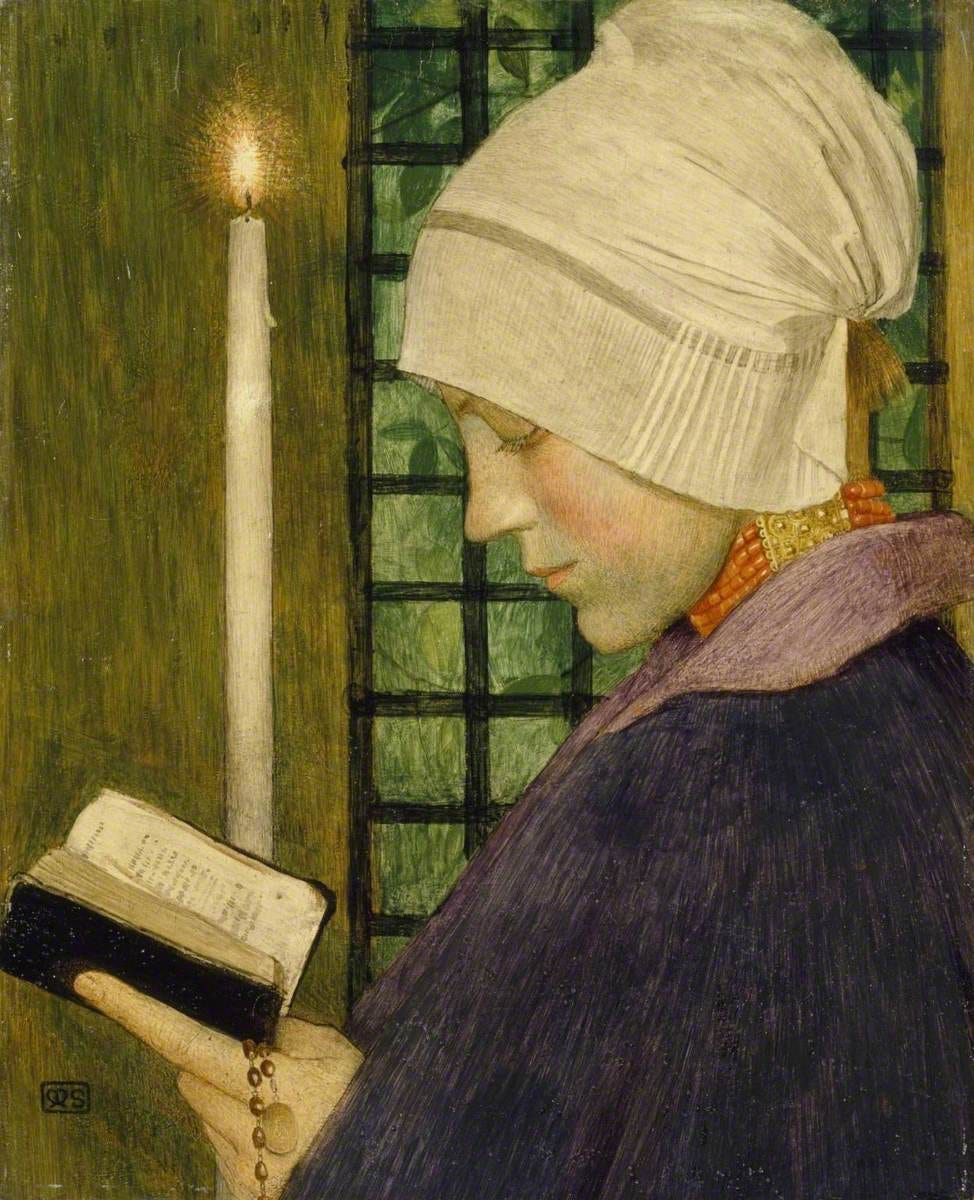
Dramatic darkness & dramatic light
The Village Green

“Few sights are more simply beautiful than that witnessed in the sombre light of this early February morning in some large church at home or abroad, when in the silence, as the mysterious words of sacrifice hurry on, one sees among the kneeling crowds the soft twinkling of innumerable tapers gradually extend over the whole church, and as the great bell tolls announcing that the Lord has once again come to His temple, taking the mind away to the scene of the first Candlemas.”
Alfred E. P. Raymund Dowling, B.A., The Flora of the Sacred Nativity (1900)\
Though Candlemas was such a widespread and beloved celebration in the Middle Ages, its popularity has waned over the centuries. I can’t help but wonder if part of the reason for this has been our decreased need for candlelight coupled with our culture’s drive to carve out independence from uncontrollable elements like the weather - to manage our vast food systems in such a way that the changing seasons and the whims of the weather are secondary considerations.
Maybe, when a supply of candles was more of a necessity (rather than an aesthetic choice), and when a spring thunderstorm or freeze could devastate fresh ground & delay crops, the training for physical dependence on the coming of light - whether through a flickering candle or the lengthening of springtime days - trained us toward dependence on the Light of Christ, too. In this sacramental worldview offered through Christianity, after all, we find the interweaving of the spiritual and the material.
Our interactions with our physical world reflect our relationships with God. Do we seek stalwart independence to such a degree that we forget our underlying dependence on God and on our neighbor, on the health of our natural world? That we forget that, underneath all our remarkable comforts, we truly are reliant on the whims of the weather?
I’m so thankful that I can flip a light switch and have immediate, electric light. It does tend to shield me, though, from the reality of the season…and it contributes to my false sense of independence, which so precariously rests on power lines. And I’m also incredibly thankful that, even when the early Spring weather brings with it frosts and storms, and the soil just isn’t friable enough to plant yet, I can still walk into a grocery store - despite the local weather woes - and find food shipped from another, warmer locale.
This ease lulls me into forgetfulness, though. Out here in the Pacific Northwest, we have a lot of trees, of course - and when a storm hits, we often lose power. And when that happens, we also lose our well pump. We store up water and keep lanterns around, but it’s always startling to me how habitual I am about my comforts - I’ll go to turn the tap on, then remember that we have no running water because the power’s out…and yet I’ll still walk right over to a light switch and habitually try to flip it on! I take these comforts for granted, despite their recent advent in human history - and despite the fact that many folks even today don’t have them.
Those power outages really expose our lack of independence. The flickering candle lighting my book page on a dark, stormy Spring night has a different quality to it than it does on any other evening - and certainly a different quality than flipping a switch.

How can we draw out the wisdom embedded in historic agrarian Candlemas, right here in our modern world? As we step into this springtime threshold, how can we use our relationship with the physical world to train us toward dependence on Christ?
Let’s recall that our modern conveniences of light, heat, & abundant food are not universal - who in our community is in need of these basic provisions, especially during temperamental spring weather?
Explore seasonal eating in our areas. Though we see daylight lengthening, it’s important to remember that we’re in the “hunger gap” right now - the hearty winter storage crops are at an end, but the spring crops aren’t in yet. Folks often enter into spring hoping for more abundance, but in reality, seasonal eating in our climate means that variety & availability will get more limited now that winter is at an end. Try learning about your local farmers, whether through them directly, or through your local market. Challenging ourselves to eat as locally as possible, whether we’re in urban or rural places, is humbling - especially during these hunger gap months.
Invite friends over for a candlelit dinner, and see if you can make do without electric lights or other conveniences. What do you notice? For me, I notice how often I reach for anything electronic - even the record player! Creating a limitation helps us to notice our habits and misplaced sense of independence.
Support your local beekeeper! Take some time to find beekeepers in your area. The pollinators that they tend are crucial to local food systems, and burning a beeswax taper hand-dipped by a local beekeeper bears with it a greater bond of relationship. (Our local beekeepers are Peter & Amy Beth from Rainy Day Bees! If you’re in the Seattle area, keep an eye out for their honey & candles!)
Try making your own candles! Whether rolling sheets of beeswax, hand-dipping, or hand-pouring, the process of making my own candles always shifts the way I think about them when it comes time to light them. I have a better sense of the time & energy that goes into these seemingly basic amenities!
As always, I offer these as aspirational ideas, not from a place of competency or expertise! That being said, the way I engage with the world around me affects the way I engage with God - if I foster the illusion of being independent of the weather and the world, I tend to foster an illusion of independence from Christ.
Candlemas invites us to recall our dependence - and to celebrate it, among our community, with a light that reminds us of our true source of life.
“The feast of the Purification also marked…the early turning of winter into spring, and it was celebrated, appropriately enough, with dramatic darkness and dramatic light. Lit with an extraordinary display of candles, the church of St. Andrew welcomed the Penifaders out of the cold dawn of a February morning. After the mass, everyone paraded around the church with candles, and when this procession ended, other candles and tapers were blessed and then saved for use.”
Judith M. Bennett, A Medieval Life: Cecilia Penifader of Brigstock, c. 1295-1344
Last year, we gathered with some friends for a chilly Candlemas celebration on the barn porch.7 We had a crêpe bar (crêpes, being round & bright, recall the returning Spring sunlight & are traditionally enjoyed for this feast; we had Meyer lemon curd, too, to really add some sunshine to a gray day!)
We also had candlemaking crafts to enjoy, so everyone could bring a Candlemas taper or votive home that, when lit on a stormy spring night later on, would recall this time with friends. We didn’t have much in the way of flowers for a centerpiece, so I went foraging in the hedgerow for hazel catkins - which look almost like floating taper candles!
Here’s a little trip down memory lane with some pictures:
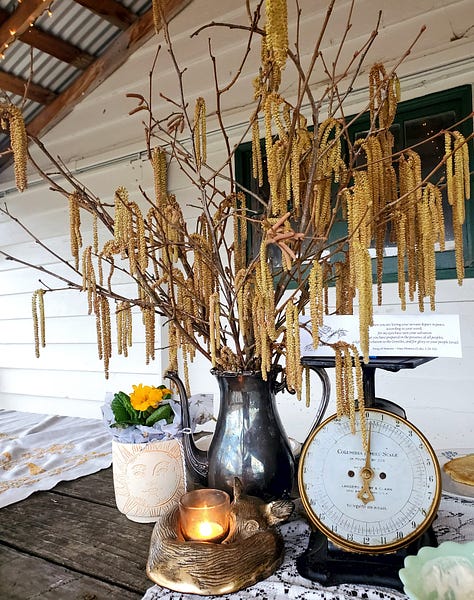
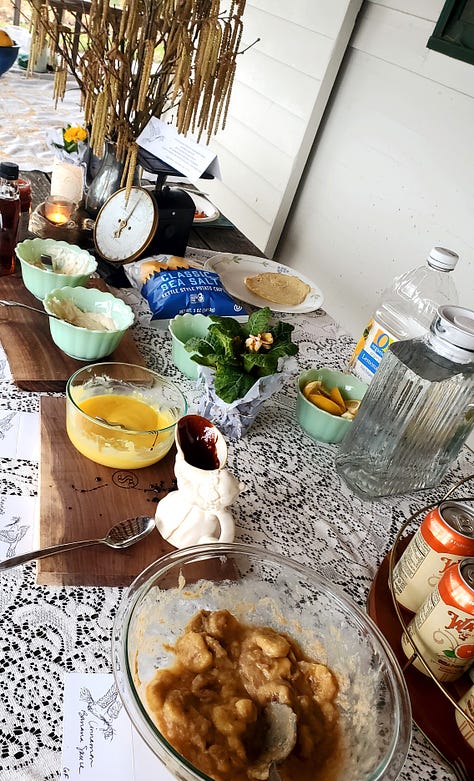
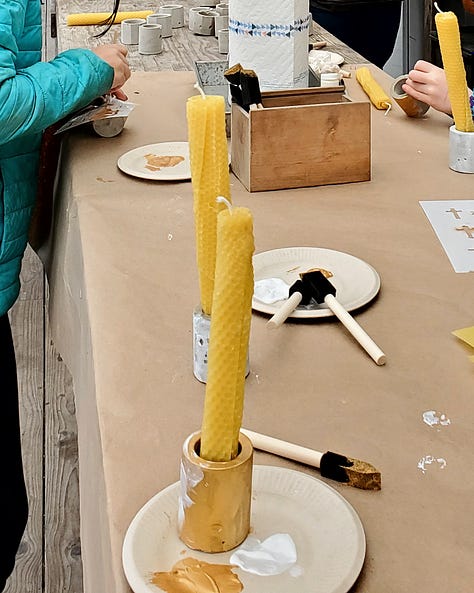
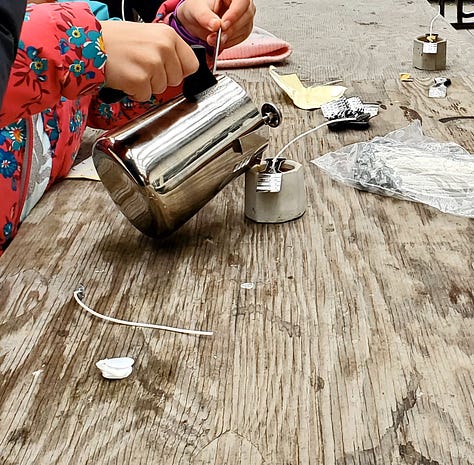
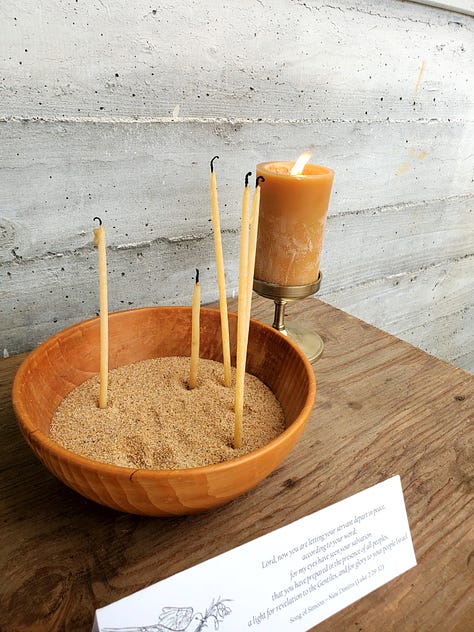
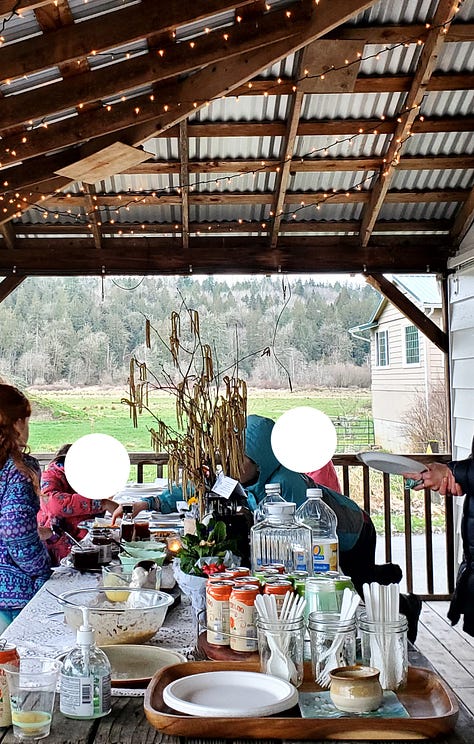
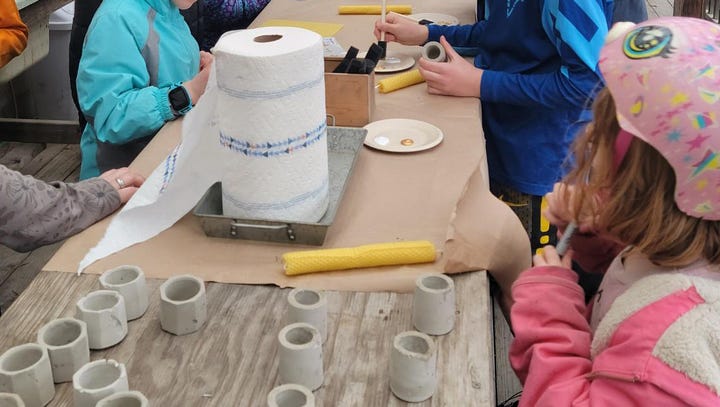
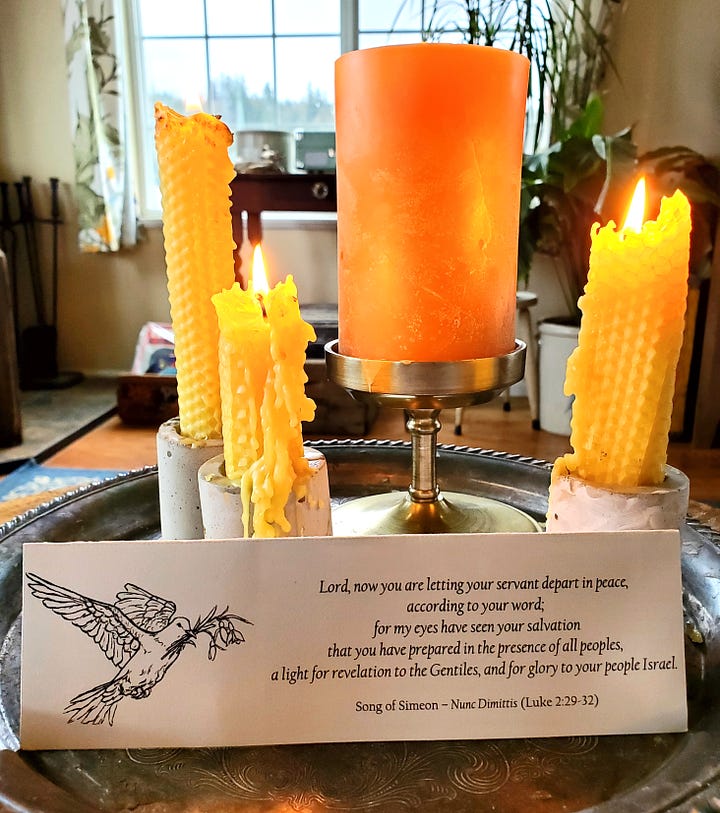
Benediction
Down with the rosemary and bays,
Down with the misletoe;
Instead of holly, now up-raise
The greener box, for show.The holly hitherto did sway;
Let box now domineer,
Until the dancing Easter-day,
Or Easter's eve appear.Then youthful box, which now hath grace
Your houses to renew,
Grown old, surrender must his place
Unto the crisped yew.When yew is out, then birch comes in,
And many flowers beside,
Both of a fresh and fragrant kin,
To honour Whitsuntide.Green rushes then, and sweetest bents,
With cooler oaken boughs,
Come in for comely ornaments,
To re-adorn the house.
Thus times do shift; each thing his turn does hold;
New things succeed, as former things grow old.Robert Herrick, “Candlemas Eve”
On this threshold of springtime, Candlemas marks a pivot in which the liturgical cycle moves from from celebrating Jesus’ birth and infancy to remembering his work of ministry and atonement. It invites us, one more time, to respond to the Christmas incarnation - to reflect the patient affirmations of Simeon & Anna in our own lives, mirroring the burgeoning natural world.
Will you be lighting a candle today?
Pax vobis,
Kristin
If you’d like to make a one-time donation, I have a PayPal Tip Jar - please know that I’m so grateful for your monetary support, which really does help me continue to do this work that I’m so passionate about!
For those who are able to support a monthly or annual paid subscription, I offer occasional new printables, extra posts, and access to my whole library of printables: the Scriptorium. I’m so grateful for your generosity, which helps to support my work through the purchase of additional books for research, art supplies, and more!
For more reflections and perspectives on the liturgical year, please visit Signs + Seasons: a liturgical living guild!
The beginning of February historically marked the beginning of Spring, with the Spring Equinox as the midpoint of it.
See Luke 2:22-40.
See Leviticus 12.
“The light shines in the darkness, and the darkness has not overcome it” (John 1:5 ESV)
St. Anselm saw the candle as an emblem of the triune nature of Christ: the wax was like the flesh of the Lord, the wick like His soul, and the flame like his divinity. Dom Prosper Guéranger, OSB in the Liturgical Year says: “St. Anselm, Archbishop of Canterbury, speaking on the same mystery, bids us consider three things in the blessed Candle: the wax, the wick, and the flame. The wax, he says, which is the production of the virginal bee, is the Flesh of our Lord; the wick, which is within, is His Soul; the flame, which burns on top, is His divinity.”
Hedge-laying is an art, and there’s sadly not much of a heritage for it in the US - but we’re learning.
For a couple of years, we’ve had a really lovely “liturgical ladies (and laddies)” group going - we meet periodically to share in these feast days together!


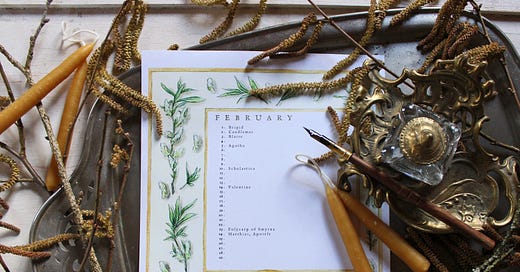



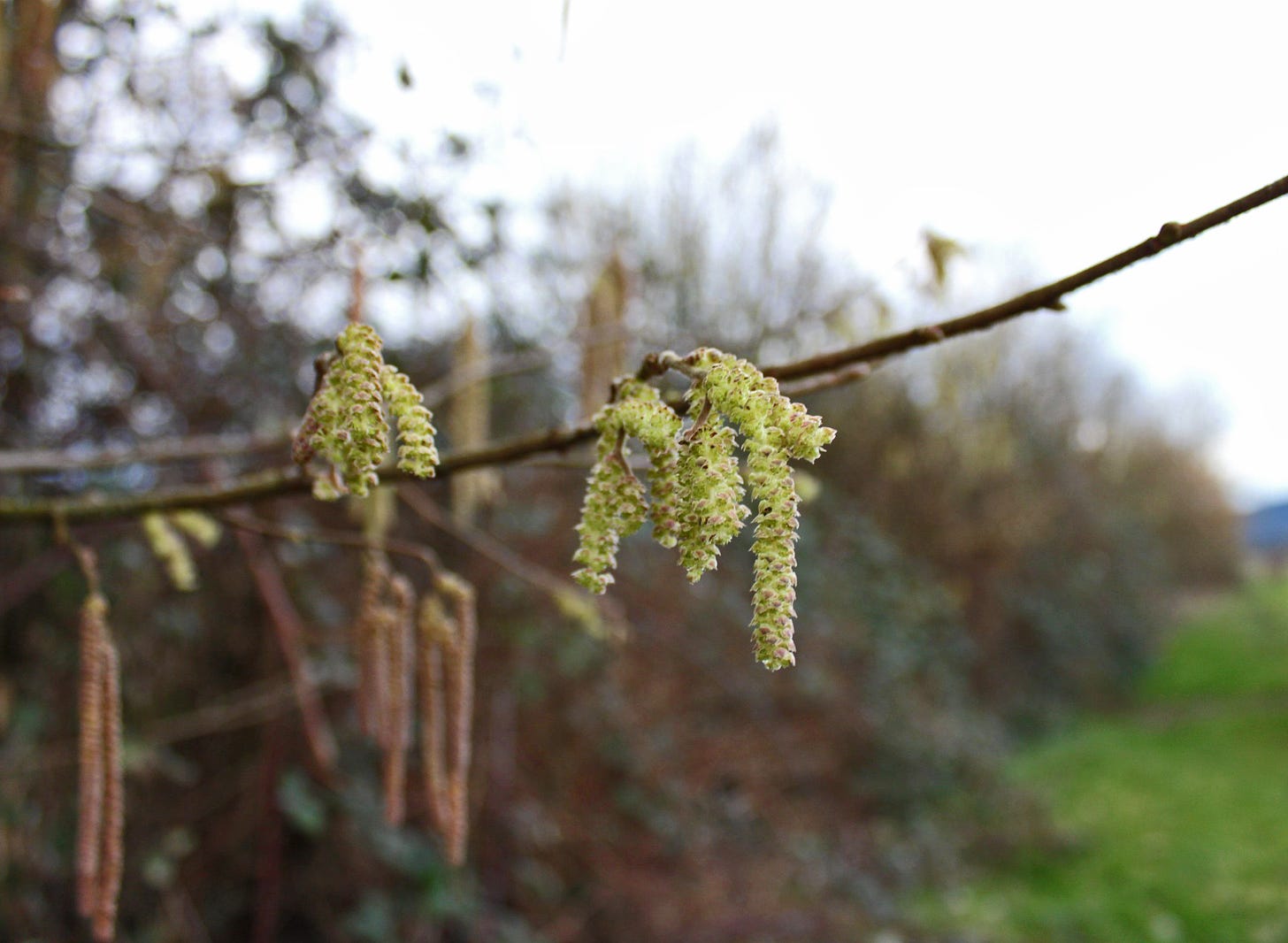
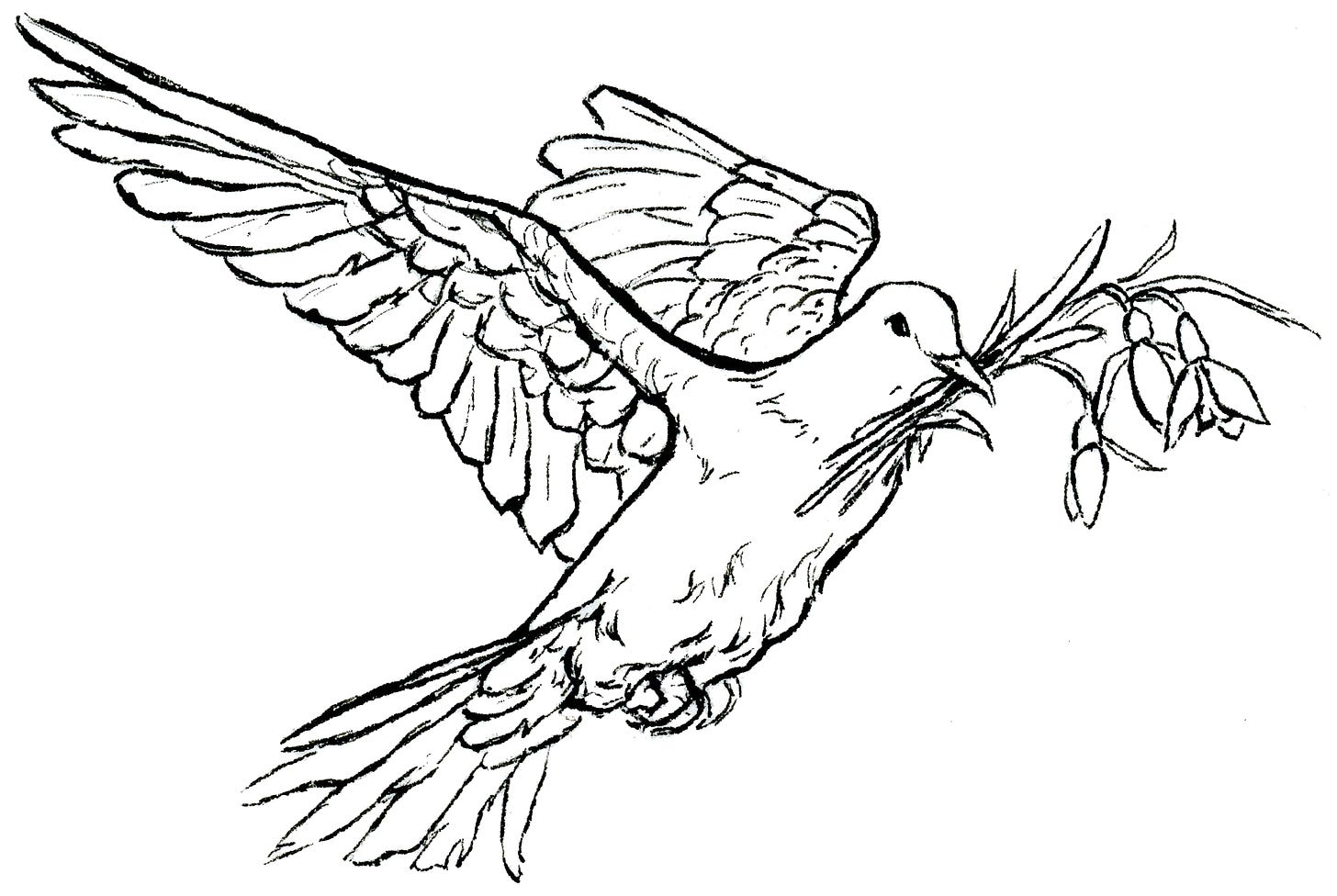


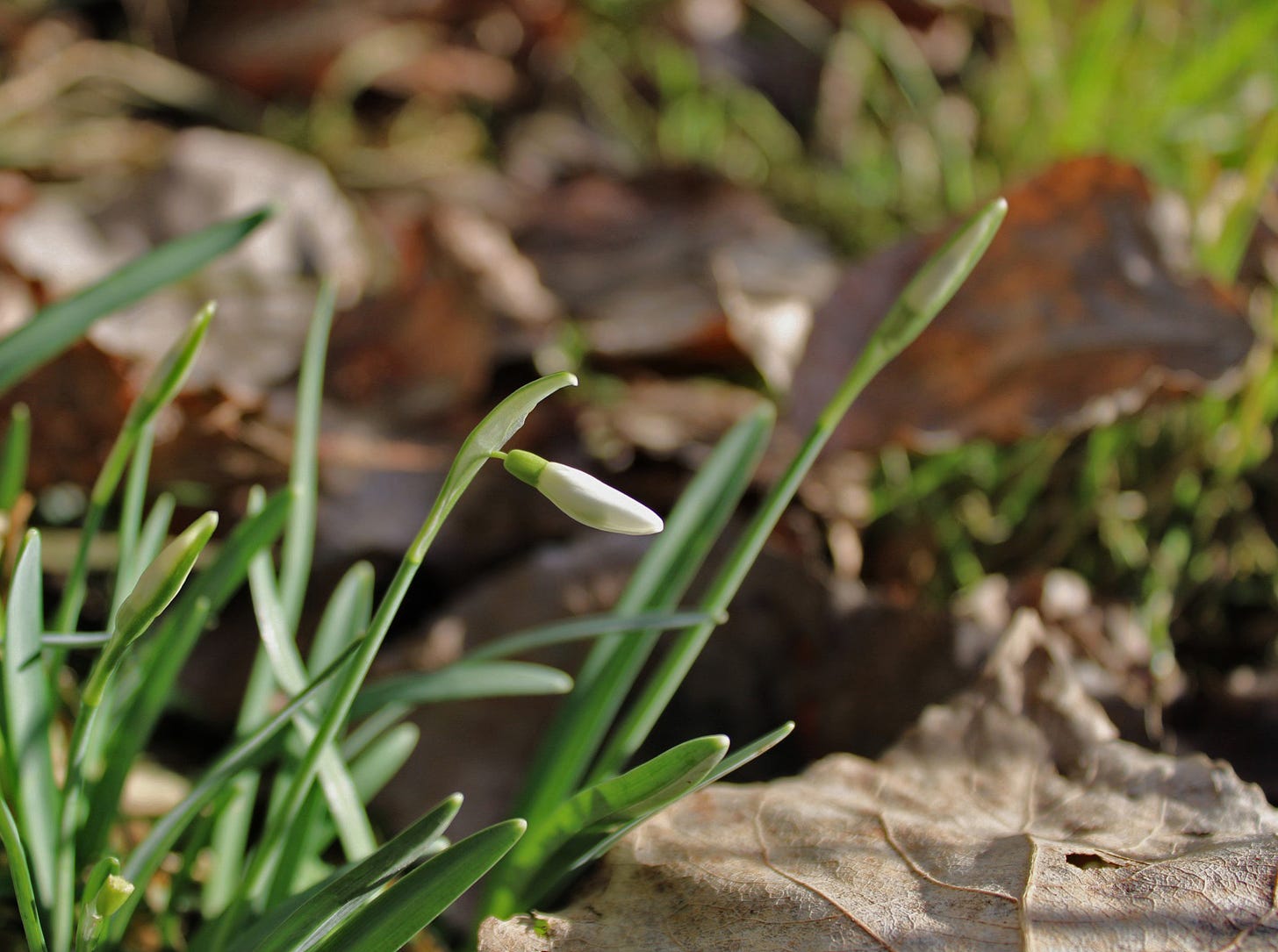
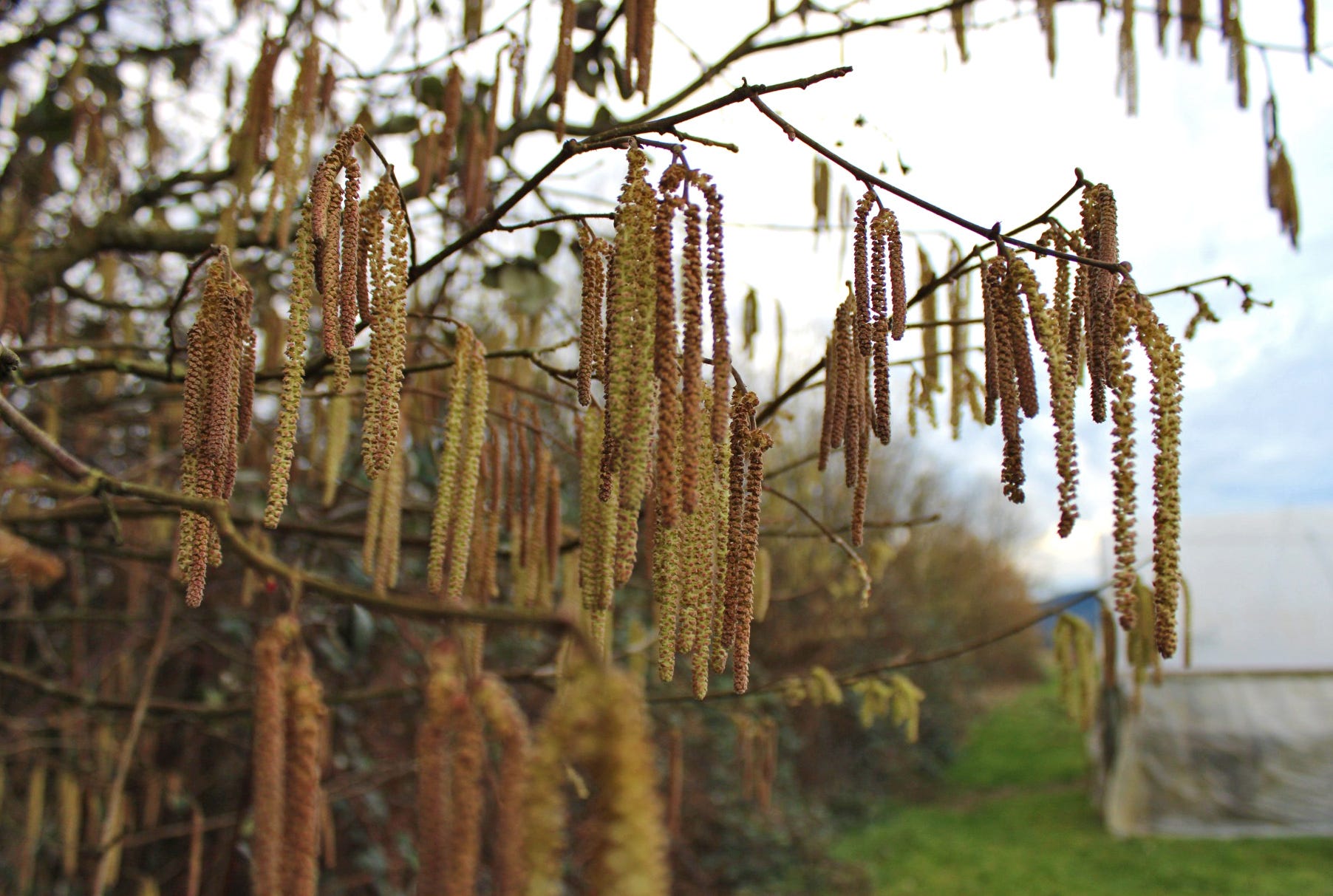
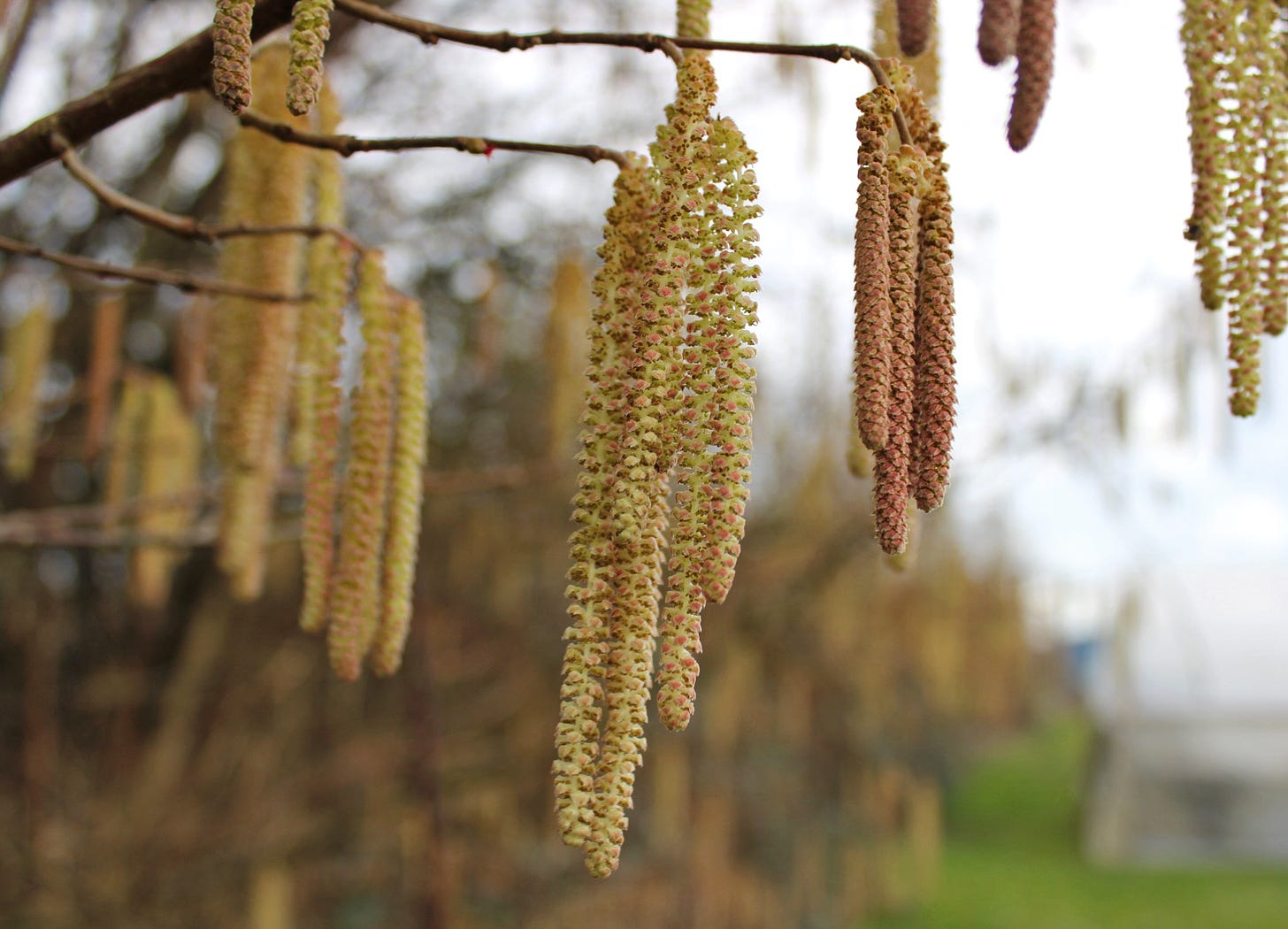
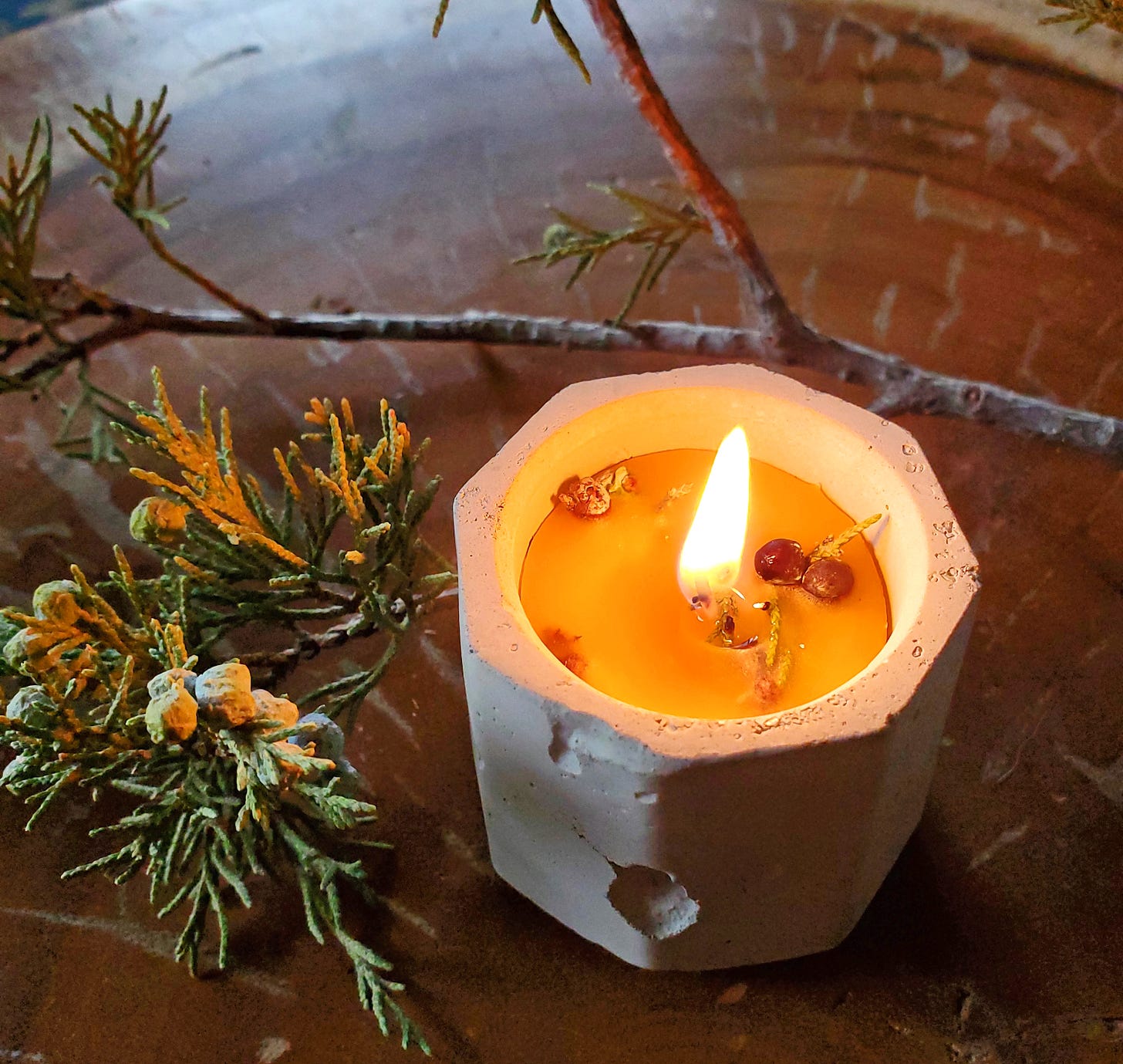

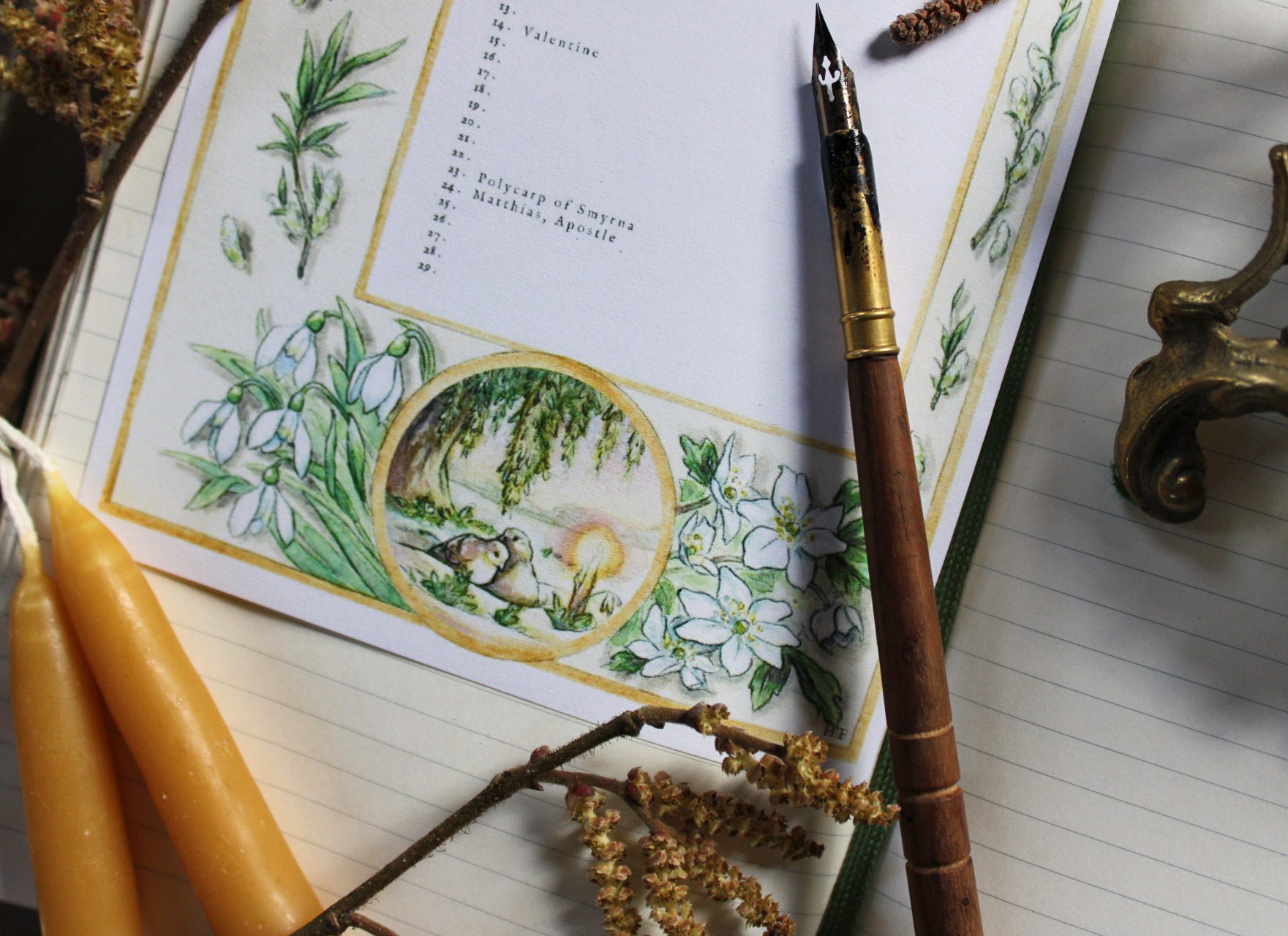
Kristin, thank you so much for this beautiful weaving of tradition and truth-centering. What a rich and deep celebration is Candlemas. The printables are lovely, especially the tags and prayer of Simeon.
The reminders you offered about having the right frame of mind about this season--as a Christian and a consumer--really resonated, especially these lines,
"the way I engage with the world around me affects the way I engage with God - if I foster the illusion of being independent of the weather and the world, I tend to foster an illusion of independence from Christ."
I appreciated your metaphors and whisper of ideas to look at the world differently, God's creation speaking at every turn. He is indeed 'speaking'--The spring peepers are noisy around here, and seem to be very early this year. It makes me happy to hear them.
Such a hope we have, God's promise of renewal, the same every year yet new each time.
Beautifully written. Thank you.
It's wonderful to remember that control, especially of nature, is an illusion: theater for the sake of comfort. I have a hard time with this one.
Your writing suggesting the connection between the inner life and the natural world also rang true. For me, this line struck the clearest:
"Come summertime, the hedgerows will be bursting with life, and sheltering foraging birds and their nests - but, for now, we see a glimpse of this future verdant activity. It makes me wonder what drab things in my heart, the obstacles that seem insurmountable, will someday give way - whether circumstantially, or whether through a change of perspective."
It makes me wonder what lessons I might receive if I made the time and left myself vulnerable enough to 'consider the lilies.'
Again, thank you.